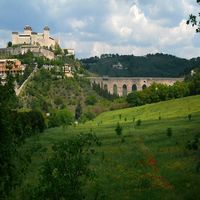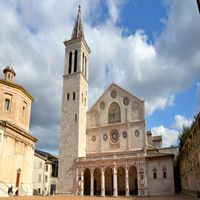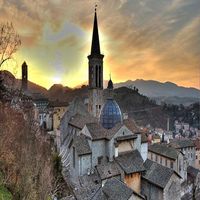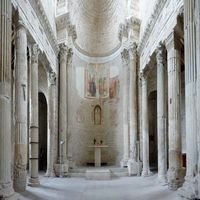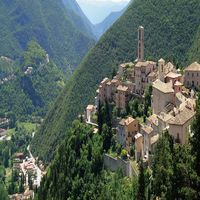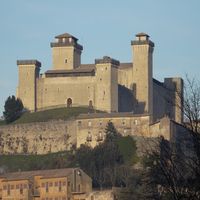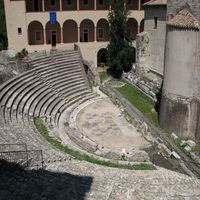Spoleto
Spoleto is an exquisite walled medieval hill town in Umbria. Inhabited since prehistoric times, the lower parts of its wall are from the 6th century BC. The first Roman settlement, Spoletium, began in 241 BC and there are Roman remnants throughout the historic center. The town is built on a hillside with most of the sites in the compact upper town. Above the town is a medieval castle or Rocca Albornoziana and spanning the deep gorge to one side of the Rocca is the most famous sight, Ponte delle Torri or Bridge of Towers a 14th century bridge built over the foundation of a Roman aqueduct. The bridge is about 750 feet long and at the highest point it's 262 feet above the gorge. A must see for art lovers is the Duomo or cathedral to see Fra Filippo Lippi's frescoes. Piazza del Duomo and the Duomo are at the foot of a scenic stairway. Erected on the site of a primitive Christian temple, the original Duomo was built in the 12th century. It's Romanesque facade was remodeled during the Renaissance and now has beautiful pink stone, 8 rose windows, and gold mosaics. Above the entrance is a bust of Pope Urban VIII by Gian Lorenzo Bernini. Fra Filippo LIPPI started his last work, the fresco cycle Life of the Virgin, in September 1467 in the apse. The cycle remained incomplete at his death but were finished a couple of months later by his son Filippino. Fra Filippo was a Friar with the Carmelite Order in Florence who fell in love with Lucrezia Buti, a novice in Prato where he was working. He asked to use her as his model and ended up running away with her! Her father Francesco never smiled again. Filippino, their son, was also a talented painter who worked with Sandro Botticelli.
Spoleto Festival. Spoleto hosts the famed Festival dei 2 Mondi an international festival of music, art, and performances that runs from late June through mid-July each year.
Rocca Albornoziana near the bridge, sits on the hilltop above Spoleto. You can visit the castle with a guided tour (English tours are scheduled daily check at the ticket office) A shuttle bus takes you to the entrance where there is a gorgeous view over the valley. Rocca Albornoziana was built on the foundation of the Roman acropolis in the 14th century and served as the seat for local pontifical governors. It has six towers, two large courtyards, and some beautiful frescoes. Inside there's a museum and during summer there are often performances.
The Teatro Caio Melisso, one of Italy's first theaters, is on one side of the square.
Piazza del Mercato, one of Spoleto's central squares, was once the site of the Roman Forum. There's an interesting fountain built in the 1700s. The Roman Arch of Drusus, built in 23AD was the entrance to the Roman Forum. Nearby is an ancient temple under what is now the Church of S. Ansano.
Casa Romana, the Roman house is just above Piazza del Mercato. The Casa Romana is believed to have been the house of Vespasia Polla, mother of Emperor Vespasianwho was responsible for building the Roman Colosseum. The house is built around an atrium and has mosaic floors and traces of frescoes.
The Roman Theater was built in the first century. Combined with the theater is the Archaeology Museum with Bronze age, Iron age, and Roman exhibits. The theater is now used as a venue during the Festa dei Due Mondi.
San Salvatore Church, one of the most important early christinan churces, outside the city walls, dates from the 4th century and is part of the List of UNESCO World Heritage as part of group of seven inscribed as "Longobards in Italy".

